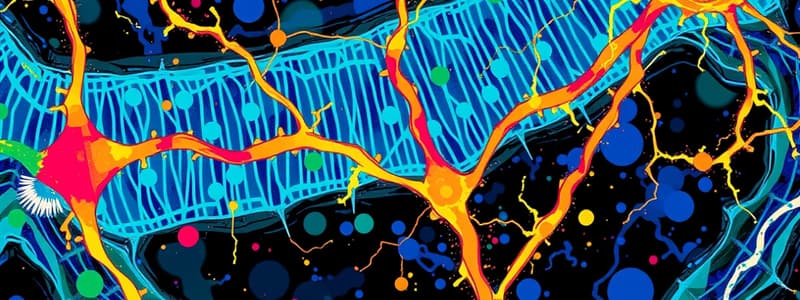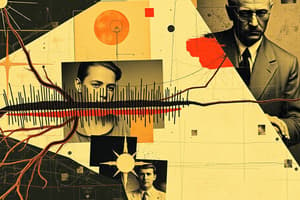Podcast
Questions and Answers
What role does histology play in neuroscience?
What role does histology play in neuroscience?
- It provides a microscopic study of tissue structure. (correct)
- It analyzes genetic sequences of neurons.
- It examines psychological behaviors.
- It measures electrical activity in neurons.
Which staining method is associated with the study of cytoarchitecture in the CNS?
Which staining method is associated with the study of cytoarchitecture in the CNS?
- Periodic acid-Schiff stain
- Hematoxylin-Eosin stain
- Immunohistochemical stain
- Nissl stain (correct)
What does the Golgi stain allow researchers to differentiate?
What does the Golgi stain allow researchers to differentiate?
- Neurotransmitter types in synapses
- Electrical conductivity of neurons
- Soma and perikaryon structures (correct)
- Different types of glial cells
Which component of the neuron is stained by the Nissl stain?
Which component of the neuron is stained by the Nissl stain?
What are neurites composed of as identified by Golgi staining?
What are neurites composed of as identified by Golgi staining?
What is the primary function of the cytoskeleton in neurons?
What is the primary function of the cytoskeleton in neurons?
Which component of the cytoskeleton is described as the strongest and most rigid?
Which component of the cytoskeleton is described as the strongest and most rigid?
What are microtubules primarily made of?
What are microtubules primarily made of?
How do microfilaments adapt to the needs of the neuron?
How do microfilaments adapt to the needs of the neuron?
Which cytoskeletal structures are implicated in dementia?
Which cytoskeletal structures are implicated in dementia?
What is a characteristic of the cytoskeleton?
What is a characteristic of the cytoskeleton?
Which structure provides the internal scaffolding for neuronal membranes?
Which structure provides the internal scaffolding for neuronal membranes?
What role do microtubules play in the structure of neurons?
What role do microtubules play in the structure of neurons?
What does the neuron doctrine state regarding neurons?
What does the neuron doctrine state regarding neurons?
What is one characteristic that distinguishes neurons from other cell types?
What is one characteristic that distinguishes neurons from other cell types?
What is the function of the nucleus found in a neuron’s soma?
What is the function of the nucleus found in a neuron’s soma?
Which part of the neuron is primarily responsible for receiving input from other neurons?
Which part of the neuron is primarily responsible for receiving input from other neurons?
What distinguishes ganglia from nuclei in the context of neuron cell bodies?
What distinguishes ganglia from nuclei in the context of neuron cell bodies?
What is a key feature of the processes extending from the neuronal soma?
What is a key feature of the processes extending from the neuronal soma?
Why are neurons considered amitotic?
Why are neurons considered amitotic?
What role do glial cells play in the nervous system?
What role do glial cells play in the nervous system?
Which method did Santiago Ramon y Cajal use to study neuroanatomy?
Which method did Santiago Ramon y Cajal use to study neuroanatomy?
What are the components contained within the neuronal soma?
What are the components contained within the neuronal soma?
What are the primary components of the central nervous system (CNS)?
What are the primary components of the central nervous system (CNS)?
What is a key characteristic of dendrites in motor neurons?
What is a key characteristic of dendrites in motor neurons?
What is the function of the axon in a neuron?
What is the function of the axon in a neuron?
What term is used to refer to long axons?
What term is used to refer to long axons?
What is the role of neurotransmitters at axon terminals?
What is the role of neurotransmitters at axon terminals?
What is the name of the region where an axon begins?
What is the name of the region where an axon begins?
Which statement accurately describes retrograde transport in axons?
Which statement accurately describes retrograde transport in axons?
How do certain viruses use axonal transport to affect neurons?
How do certain viruses use axonal transport to affect neurons?
What is the process of synaptic transmission?
What is the process of synaptic transmission?
What can happen if there is dysfunction in synaptic transmission?
What can happen if there is dysfunction in synaptic transmission?
Which direction does anterograde transport occur in an axon?
Which direction does anterograde transport occur in an axon?
What is the significance of axon collaterals?
What is the significance of axon collaterals?
What types of signals do dendrites convey towards the cell body?
What types of signals do dendrites convey towards the cell body?
What component of the axon plays a key role in generating nerve impulses?
What component of the axon plays a key role in generating nerve impulses?
What structural feature is present at the distal ends of axons?
What structural feature is present at the distal ends of axons?
What role do interneurons primarily serve in the nervous system?
What role do interneurons primarily serve in the nervous system?
Which type of neuron is characterized by the type of neurotransmitter they utilize?
Which type of neuron is characterized by the type of neurotransmitter they utilize?
Which of the following glial cells is MOST abundant in the central nervous system?
Which of the following glial cells is MOST abundant in the central nervous system?
What is the primary function of oligodendrocytes in the central nervous system?
What is the primary function of oligodendrocytes in the central nervous system?
How do ependymal cells contribute to the function of the central nervous system?
How do ependymal cells contribute to the function of the central nervous system?
What characterizes myelinated fibers in the nervous system?
What characterizes myelinated fibers in the nervous system?
What is a key difference between Schwann cells and oligodendrocytes?
What is a key difference between Schwann cells and oligodendrocytes?
What is the primary function of astrocytes in the central nervous system?
What is the primary function of astrocytes in the central nervous system?
What is a characteristic of microglial cells?
What is a characteristic of microglial cells?
What happens at the myelin sheath gaps in the peripheral nervous system?
What happens at the myelin sheath gaps in the peripheral nervous system?
Which statement about white matter is true?
Which statement about white matter is true?
What primary function do satellite cells serve in the peripheral nervous system?
What primary function do satellite cells serve in the peripheral nervous system?
Which type of myelination is formed by Schwann cells?
Which type of myelination is formed by Schwann cells?
Flashcards are hidden until you start studying
Study Notes
Neuronal Membrane Channels and Cytoskeleton
- Neuronal cytoskeleton is dynamic, providing structural support to the membrane.
- Composed of three main structures:
- Microtubules: Thick, hollow tubes of tubulin; capable of polymerization to form various shapes.
- Microfilaments: Thin, actin-based tubes that frequently change shape.
- Neurofilaments: Provide rigidity, akin to the skeletal framework of neurons.
Parts of a Neuron
- Neurons consist of processes extending from the cell body, which differ between CNS (central nervous system) and PNS (peripheral nervous system).
- CNS contains both cell bodies and processes, while PNS primarily consists of neuron processes.
- Tracts: Bundles of neuron processes in the CNS.
- Nerves: Bundles of neuron processes in the PNS.
Dendrites
- Motor neurons may possess hundreds of dendrites, which act as receptive regions collecting information.
- Dendrites convey incoming signals towards the cell body as graded potentials.
- Specialized structures called dendritic spines enhance information collection.
The Axon
- Each neuron has a single axon originating from the axon hillock, varying in length.
- Axons may contain branches called axon collaterals and can branch extensively at their terminals, with up to 10,000 terminal branches.
- Axon Function: Conducts nerve impulses and transmits them to the axon terminals, which secrete neurotransmitters affecting neighboring neurons.
Transport Mechanisms
- Anterograde transport: Movement away from the cell body, transporting organelles such as mitochondria.
- Retrograde transport: Movement toward the cell body, crucial for degrading organelles and signaling molecules.
- Certain viruses exploit retrograde transport for entry into neurons, providing a research avenue for gene therapy.
Synaptic Transmission
- Fundamental communication between neurons occurs at synapses, involving conversion of electrical signals to chemical signals and back.
- Dysfunction in synaptic transmission can lead to mental disorders.
Histology in Neurons
- Histology: Study of tissue structure, essential for understanding neuron classification.
- Nissl Stain: Stains neuronal cell bodies for studying cytoarchitecture; shows spatial area.
- Golgi Stain: Allows visualization of complete neuron structures, differentiating soma from processes (neurites).
Neuron Doctrine
- Neuronal structure adheres to cell theory; neurons are the smallest anatomical units.
- Neurons communicate through contact, with neurites not forming physical connections.
Characteristics of Neurons
- Neurons are long-lived, amitotic (rarely divide), and have high metabolic demands.
- Composed of a cell body (soma) containing organelles and a plasma membrane serving as a receptive region.
Components of the Neuronal Soma
- Contains cytosol (fluid), organelles (membrane-bound structures), and cytoplasm (cell contents excluding the nucleus).
- The nucleus is vital for gene expression and RNA processing.
Functional Classifications of Neurons
- Interneurons: Most abundant (99%); transmit signals within the CNS, connecting motor and sensory pathways.
- Classification through genetic expression is increasingly common, utilizing transgenic technology.
Glial Cells in CNS and PNS
- CNS contains four main types of glial cells:
- Astrocytes: Support neurons, regulate their environment, and participate in information processing.
- Microglial Cells: Act as immune cells, monitoring for injury and debris removal.
- Ependymal Cells: Line brain cavities and assist in cerebrospinal fluid circulation.
- Oligodendrocytes: Form myelin sheaths around CNS axons, increasing signal transmission speed.
Myelin Sheathing
- Myelin protects axons and enhances impulse speed; formed by oligodendrocytes in the CNS and Schwann cells in the PNS.
- Myelinated fibers: Have segments of myelin sheath, while nonmyelinated fibers lack this insulation.
- Nodes of Ranvier: Gaps between myelin segments, facilitating rapid signal transmission.
Studying That Suits You
Use AI to generate personalized quizzes and flashcards to suit your learning preferences.



